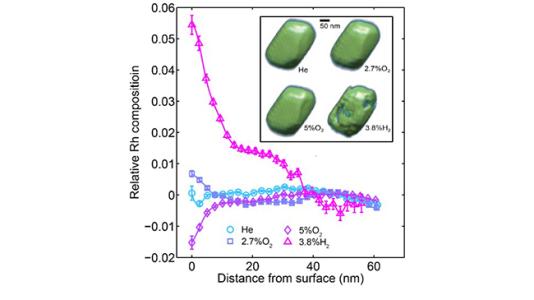
Scientific Achievement
Bragg coherent diffraction imaging (BCDI) revealed that surface reactions influence and redistribute the internal composition of binary alloy nanoparticles under oxidizing and reducing environments at elevated temperatures.
Significance and Impact
The observed dynamic composition redistributions indicate that compositional evolution must be taken into account for rational design of nanoscale electrocatalytic materials.
Research Details
- Structural and compositional changes in Pt/Rh alloy nanoparticles were measured with BCDI in-situ under oxidizing and reducing gas environments at temperatures of 550˚ -700˚C.
- Using a new BCDI analysis developed to spatially resolve alloy composition, significant redistribution was observed between the particle core and surface at a few-minutes time scale.
- The average composition of Rh and the surface Rh composition were found to vary by formation and reduction of RhOX.
Work was performed at Argonne National Laboratory.
Argonne National Laboratory seeks solutions to pressing national problems in science and technology. The nation’s first national laboratory, Argonne conducts leading-edge basic and applied scientific research in virtually every scientific discipline. Argonne researchers work closely with researchers from hundreds of companies, universities, and federal, state and municipal agencies to help them solve their specific problems, advance America’s scientific leadership and prepare the nation for a better future. With employees from more than 60 nations, Argonne is managed by UChicago Argonne, LLC for the U.S. Department of Energy’s Office of Science.
The U.S. Department of Energy’s Office of Science is the single largest supporter of basic research in the physical sciences in the United States and is working to address some of the most pressing challenges of our time. For more information, visit https://energy.gov/science.